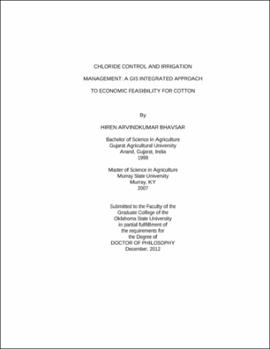| dc.contributor.advisor | Stoecker, Arthur | |
| dc.contributor.author | Bhavsar, Hiren Arvindkumar | |
| dc.date.accessioned | 2013-11-26T08:21:58Z | |
| dc.date.available | 2013-11-26T08:21:58Z | |
| dc.date.issued | 2012-12 | |
| dc.identifier.uri | https://hdl.handle.net/11244/6504 | |
| dc.description.abstract | This study estimates the net agricultural benefits of preventing nearly 500 tons of salt per day, sufficient to preclude irrigation or potable water use, from entering the Elm Fork of the Red River near the Texas border in far western Oklahoma. The project has the potential to bring irrigation to part of an additional 50,000 acres of irrigable land located along the Elm and North Fork rivers in Southwest Oklahoma. This study describes the incorporation of recent advances in GIS, crop simulation models, econometrics, and dynamic optimization into the agricultural benefit-cost analysis of chloride or salinity reduction. GIS was used to identify the area and spatial distribution of irrigable soils in sections of land within prescribed distances from a watercourse. It was then possible to determine the areas that could be irrigated with a specific type of irrigation system such as a center pivot or a traveling reel. The overall economic feasibility analysis consists of two cotton prices, three salinity levels and three levels of rainfalls. GIS allows determination of areas of each soil type than would be irrigated by individual systems along with well to pivot distances. Dynamic optimization over a 50-year period provides location specific estimates of producer profits along with changes in soil salinity and crop yield. The results show that lower salinity (irrigation water EC) and higher price increases the yields and hence the net incremental benefits. The results range from 5 million (2.2 dS/m and 0.54 cotton price) to 100 million (0.9 EC and 0.7 cotton price) for the average rainfall scenario. The results are highly sensitive to changes in the salinity, rainfall and cotton price. Optimal irrigation water applied per acre was affected mainly by the salinity and cotton price. | |
| dc.format | application/pdf | |
| dc.language | en_US | |
| dc.rights | Copyright is held by the author who has granted the Oklahoma State University Library the non-exclusive right to share this material in its institutional repository. Contact Digital Library Services at lib-dls@okstate.edu or 405-744-9161 for the permission policy on the use, reproduction or distribution of this material. | |
| dc.title | Chloride control and irrigation management: A GIS integrated approach to economic feasibility for cotton | |
| dc.contributor.committeeMember | Vitale, Jeffrey Dunn | |
| dc.contributor.committeeMember | Epplin, Francis M. | |
| dc.contributor.committeeMember | Godsey, Chad B. | |
| osu.filename | Bhavsar_okstate_0664D_12527.pdf | |
| osu.accesstype | Open Access | |
| dc.type.genre | Dissertation | |
| dc.type.material | Text | |
| thesis.degree.discipline | Agricultural Economics | |
| thesis.degree.grantor | Oklahoma State University | |
